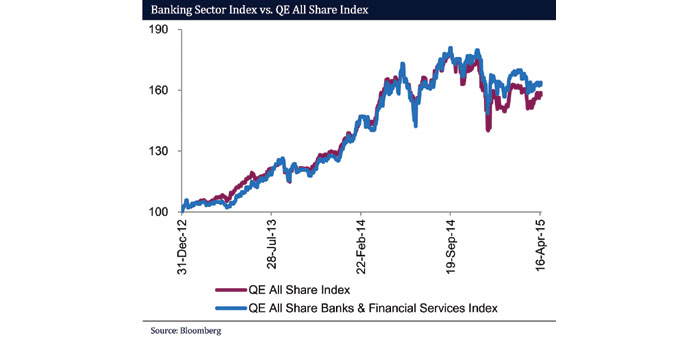Qatar banking sector’s loan book grew 3.2% month-on-month in March after growing by 1.7% MoM in February, QNB Financial Services (QNBFS) has said in an update.
Deposits followed suit and gained 3.1% MoM (+3.3 YTD) in March, QNBFS said.
Public sector drove total credit growth with a gain of 4.6% MoM (down 1.3% YTD).
Moreover, public sector deposits ticked up by 1.3% MoM, but were “flattish”, year-to-date (YTD).
Thus, the loans to deposit ratio (LDR) remained at 109% in March.
The public sector deposits climbed up 1.3% MoM for March 2015 compared with a robust growth of 5.2% MoM in February.
Delving into segment details, the government institutions’ segment (representing 59% of public sector deposits) declined by 6.6% MoM (+4.2% YTD) in March.
Moreover, the semi-government institutions’ segment posted weak performance, contracting by 19.4% MoM (down 16.2% YTD).
On the other hand, the government segment surged by 50.1% MoM (+2.6% YTD) after dropping by 11.4% and 22.9% in February and January 2015, respectively.
On the private sector front, the companies and institutions’ segment gained 2.5% MoM (down 2.4% YTD).
The consumer segment followed suit and climbed up by 2.2% MoM (+4.9% YTD). Non-resident deposits grew by 15.5% MoM (+31.4% YTD).
The overall loan book continued its “growth trajectory” and “posted healthy performance”. Total domestic public sector loans increased by 4.6% MoM (down 1.3% YTD) compared a marginal growth of 1.5% MoM in February 2015.
The government segment’s loan book expanded by 23.7% MoM (+5.7% YTD). Moreover the government institutions’ segment, which represents 60% of public sector loans, exhibited flattish performance after declining by 2.5% MoM in February (down 2.4% YTD).
However, semi-government institutions’ segment declined by 11.9% MoM (down 12.3% YTD). Hence, the government sub-segment pushed the overall loan book up for the month of March 2015.
Private sector loans grew by 3.1% MoM (+4.7% YTD) in March as opposed to a flattish performance in February.
The services segment followed by consumption and others positively contributed toward the loan growth.



